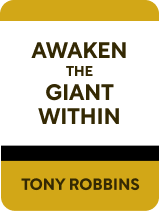

This article is an excerpt from the Shortform book guide to "Awaken the Giant Within" by Tony Robbins. Shortform has the world's best summaries and analyses of books you should be reading.
Like this article? Sign up for a free trial here .
Are you looking for quotes from Awaken the Giant Within? How can you apply these quotes to your own life?
In Awaken The Giant Within, Tony Robbins offers advice for improving your life and mindset. Passages from this book can help you take control of your life, make better decisions, and improve your well-being.
Keep reading for the best Awaken the Giant Within quotes, with explanations.
Awaken the Giant Within: Quotes and Explanations
The following quotes from Awaken the Giant Within will help you apply insights from the book to your own life:
“Enjoy making decisions. You must know that in any moment a decision you make can change the course of your life forever: the very next person you stand behind in line or sit next to on an airplane, the very next phone call you make or receive, the very next movie you see or book you read or page you turn could be the one single thing that causes the floodgates to open, and all of the things that you’ve been waiting for to fall into place. If you really want your life to be passionate, you need to live with this attitude of expectancy.”
The first step in taking control of your life is understanding the power of your decisions. Many people mistakenly believe their lives are shaped by their circumstances—they go where the current takes them without making any active decisions, feeling out of control. However, life is actually dictated by decisions. When you make a decision about who you are and what you want, you’re making a commitment to do anything necessary to realize that vision. Each decision—no matter how small—sets into motion a series of actions and events that ultimately shape your life.
“Any time you sincerely want to make a change, the first thing you must do is to raise your standards.”
The standards you set dictate your aspirations, your expectations of yourself, and what you’re willing to tolerate. Awaken the Giant Within helps you identify what your current standards are and determine what they need to be to create your ideal life.
“Changing an organization, a company, a country—or a world—begins with the simple step of changing yourself.”
As you make giving back and supporting a cause a regular part of your life, don’t neglect your own needs. Your ability to give back depends on your well-being, and you shouldn’t sacrifice yourself to make a positive impact on others. Additionally, when you understand that giving back doesn’t have to come at the expense of your self-care, you’ll give back more because you’ll eliminate any pain associated with dedicating your time to contribution.
“Three decisions that we all control each moment of our lives: what to focus on, what things mean, and what to do in spite of the challenges that may appear to limit us.”
No matter your circumstances, there are three critical decisions that you make constantly—whether or not you realize it—which impact what you notice, how you feel, what you do, and who you become. Controlling these three decisions is the first step in controlling your life and your destiny:
- Decide what you focus on.
- Decide what certain things mean to you.
- Decide what you’re doing to produce the results you want.
If you’re not living the life you want, change the way you’re making these three decisions moment-to-moment. This will help you to understand and implement Tony Robbins’ ultimate success formula.
“Your brain can’t tell the difference between something you vividly imagine and something you actually experience.”
Your imagination is a critical source of empowering references because it’s not limited by what’s already happened, but rather makes what could happen possible. Gather references from things that you imagine so vividly that it feels like it actually happened or that it could happen, and use these to support empowering beliefs about what could be. For example, athletes often visualize themselves successfully running plays, scoring points, and winning games—all of which helps them to make those visions a reality when it’s game time.
“For most people, the fear of loss is much greater than the desire for gain.”
The answer lies in our pain and pleasure associations. The driving force behind all of our decisions—and, thus, our actions—is the motivation to avoid pain and seek pleasure. For instance, when we indulge in a junk-food habit, it’s because we gain pleasure from munching on salty snacks, and we associate pain with eating veggies instead. There are different forms of pain (such as inconvenience and humiliation) and pleasure (such as ecstasy and comfort). Generally, fear of pain or loss is a stronger motivator than the desire for pleasure or gain—in other words, you’ll continue to eat junk food if your love of chips isn’t as strong as your aversion to healthy food.
“Know that it’s your decisions, and not your conditions, that determine your destiny.”
Remember the power of decisions. Each decision—no matter how small—sets into motion a series of actions and events that ultimately shape your life. The best part is that you can make a decision anytime, so when you feel helpless or overwhelmed, remember that you can make a decision to change something.
“Achievers rarely, if ever, see a problem as permanent, while those who fail see even the smallest problems as permanent.”
A potent and pervasive form of limiting belief is learned helplessness. Learned helplessness results from generalizing one or more failures into a global belief about your incompetence: You believe that nothing you could possibly do would make a positive difference. People who suffer from learned helplessness quickly give up when they face challenges because they assume they’ll fail, which prevents them from ever having the chance to succeed. Conversely, optimistic, high-achieving people find ways to overcome failure.
Psychologist Martin Seligman has extensively studied learned helplessness and has identified three patterns of belief that support it:
- Permanence: People who persevere in the face of adversity see their problems as temporary, while people who suffer from learned helplessness perceive their challenges as permanent.
- Pervasiveness: People who persist despite obstacles see their challenges as specific to a particular area of their life, while people who feel helpless interpret the same challenges as pervasive or global. For example, the first type of person may acknowledge that she has a habit of overeating, while the second type of person generalizes this belief and thinks that he is a gluttonous and weak-willed person.
- Personal: People who carry on after failure believe that they need to change their approach in order to succeed in the future, while people who feel helpless assume that the problem is them.
“The quality of your life is a direct reflection of the quality of the questions you are asking yourself”
The questions you ask yourself set the tone for your thought patterns, so it’s critical to make a habit of asking yourself positive, empowering questions that will lead to empowering thoughts.
Thinking is merely a sequence of asking and answering questions—in other words, virtually every thought you have is preceded by a question, even if it’s not one you consciously asked. Some questions are straightforward ways of evaluating your environment, like asking what made a noise. Other questions interpret your circumstances subjectively, and the answers you come up with strongly influence your emotional state.
Everyone has a set of subjective habitual questions or types of questions that they ask themselves regularly. Since your habitual questions create your thought patterns, and thoughts determine your behavior, if you consistently ask yourself disempowering questions, you will feel worse and you do less to improve your life. You can change your life by becoming aware of your habitual questions and changing those that are disempowering.
The above 9 quotes from Awaken the Giant Within will help you to better understand passages from the book and apply them to your own life.

———End of Preview———
Like what you just read? Read the rest of the world's best book summary and analysis of Tony Robbins's "Awaken the Giant Within" at Shortform .
Here's what you'll find in our full Awaken the Giant Within summary :
- How to make transformational changes to your life through small adjustments
- How you create your destiny every time you start a sentence with “I am…”
- Strategies to take control of your thoughts and emotions






